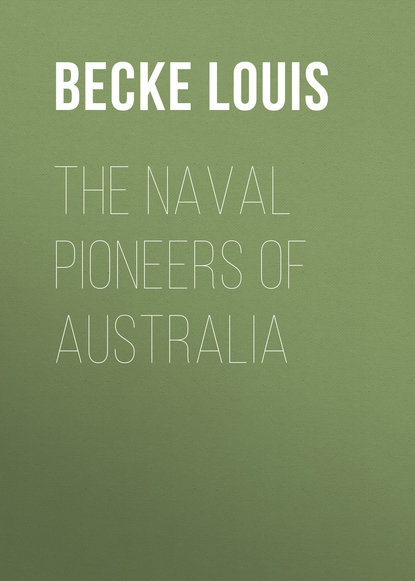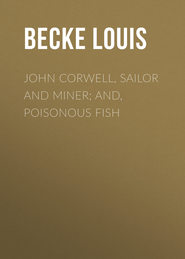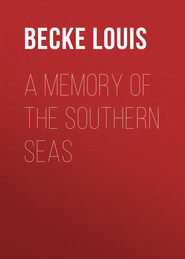По всем вопросам обращайтесь на: info@litportal.ru
(©) 2003-2024.
✖
The Naval Pioneers of Australia
Настройки чтения
Размер шрифта
Высота строк
Поля
While the ship was being overhauled under the sweltering rays of a tropical sun, the men lived on shore in a tent, and Dampier, who was tired of the voyage, probably because there were no Spaniards to fight and no prizes to be made, endeavoured to persuade his companions to shape their next course for some port where was an English factory; but they would not listen to him, and for his pains he was threatened that when the ship was ready for sea he should be landed and left behind.
Evelyn tells us that in 1698 Dampier was going abroad again by the King's commission, and this second voyage of the ex-buccaneer to the South Seas, although of small importance to geographers, is noteworthy, inasmuch as Dampier's was the first visit of a ship of the English royal navy to Australian seas.
To understand what sort of an expedition was this of two hundred years ago, how Dampier was equipped and what manner of ship and company he commanded, it will not be out of place to give some account of the navy at that time. When James II. abdicated in 1688, according to Pepys, the royal navy was made up of 173 ships of 101,892 tons, an armament of 6930 guns, and 42,003 men. William died in 1702, and the number of ships had then increased to 272, and the tonnage to 159,020 tons.
The permanent navy, begun by Henry VIII. and given its first system of regular warfare by the Duke of York in 1665, had become well established, and trading vessels had ceased to form a part of the regular establishment. King William III., although not so good a friend to the service as his predecessor, and anything but a sailor, like the fourth William, did not altogether neglect it. In the Introduction to James' Naval History we are told that between the years 1689 and 1697 the navy lost by capture alone 50 vessels, and it is probable that an equal number fell by the perils of the sea. King William meantime added 30 ships, and half that number were captured from the French, while several 20 and 30-gun ships were besides taken from the enemy.
Coming back to the first naval expedition to Australia, the ship commanded by Dampier was the Roebuck, as Evelyn tells us, a vessel of 290 tons. Dampier has left very little description of his ship, but it is not difficult to picture her, for by this time the ratings of ships had been settled upon certain lines, and the meaning of the word "rating" as used at this period is easily ascertainable.
According to Charnock's Marine Architecture, the Roebuck, lying at Deptford in June, 1684, was a sixth-rate of 24 guns and 85 men. This was her war complement; but Dampier himself tells us that he "sailed from the Downs early on Saturday, January 14th, 1699, with a fair wind, in His Majesty's ship the Roebuck, carrying but 12 guns on this voyage and 50 men with 20 months' provisions."
In 1677, according to James' History, the smallest fifth-rate then afloat corresponds nearest to the Roebuck, and, no doubt, by Dampier's time this vessel had been reduced in her rating. The vessel of 1677 is described as being of 265 tons and 28 guns, "sakers and minions," with a complement of about 100 men. The largest sixth-rate was 199 tons, 18 guns, and 85 men. So from these particulars we can take it as correct that the Roebuck in 1699 was a sixth-rate. It is worth remembering that in Cavendish's second expedition to the South Sea, in 1591, there was a ship called the Roebuck, commanded by John Davis, and likely enough the sixth-rate in which Dampier sailed was named after her, those who gave her the name little thinking at the time of her christening (she was built before Dampier's voyage, and was certainly not the Roebuck of Cavendish's fleet) how appropriately they were naming her for her future service.
Her armament is a matter of interest, for just about her time—that is, between the years 1685 and 1716—the naming of guns after beasts and birds of prey went out of fashion, and they were distinguished by the weight of the shot fired. James, quoting from Sir William Monson's Naval Tracts, supplies the following table on the subject of sea guns; and, as they were probably still in use in Dampier's time, we print it here:—
The small arms were matchlocks, snaphainces, musketoons, blunderbusses, pistols, halberts, swords, and hangers.
From this it will be seen that the Roebuck's guns, considering the peaceful service she was upon, were probably known to her company as "sakers" and "falcons."
In a sixth-rate the sakers were carried all on the one deck, and the minions on the quarterdeck. Charnock supplies an illustration of a sixth-rate of the time, and the picture is a familiar one to all who have taken even a slight interest in the ships of a couple of centuries ago. A lion rampant decorates the stem, set as it remained till early in the present century (the galley prow had gone with Charles I.); the hull looked not a whit more clumsy than that of an old north-country collier of our youth, but the flat stern, with its rows of square windows, richly carved panelling, and big stern-lanterns, and the row of round gun-ports encircled by gold wreaths along the ship's sides, are distinctive marks of this period.
A vessel of this kind was ship-rigged, about 88 feet long by 24 feet beam; the depth of her hold, in which to store her twenty months' provisions (a marvellously large quantity as stores were then carried), was about 11 feet, and her draught of water when loaded about 12 feet aft. She had one deck and a poop and forecastle, the former extending from either end of the ship to the waist. A good deal of superfluous ornament had by this time been done away with, although there was plenty of it so late as 1689. Charnock describes a man-of-war of that date. After the Restoration, ships grew apace in grandeur in and out. Inboard they were painted a dull red (this was, it is said, so that in fighting the blood of the wounded should not show), outside blue and gilded in the upper parts, then yellow, and last black to the water-line, with white bottoms. Copper sheathing had not come into use, and ships' bottoms were treated with tallow, which was made to adhere by being laid on between nails which studded the bottom.
The pitching of the vessels imperilled the masts of these somewhat cranky ships of 1689, says a writer of about Dampier's time, who also tells us that ships then had awnings, and that "glass lanthorns were worthier best made of crystal horn; lanthorns were worthier than isinglass."
The sails were the usual courses: big topsails and topgallantsails, staysails, and topmastsails, with a spritsail and a lateen-mizen; the spanker and jib were not yet, but the sprit-topsail had just gone out. The ship when rigged and fitted ready for sea probably cost King William's Admiralty about £10,000. But the Roebuck was pretty well worn out when Dampier was given the command of her, as he tells us when relating her subsequent loss.
The British Fleet, by Commander C.N. Robinson, is an invaluable book to the student of naval history, and, notwithstanding plenty of book authorities and ten years' study of the subject, the present writers are compelled to draw upon Commander Robinson for many details. With the aid of this work and from allusions to be found in the writings of a couple of centuries ago, it is possible to make some sort of picture of Dampier's companions in the Roebuck.
Dampier himself was a type of naval officer who entered the service of the country by what was then, and remained for many years afterwards, one of the best sources of supply. He had been given a fair education, and had been duly apprenticed and learned the profession of a sailor in a merchant ship. Upon his return from his first voyage to the South Seas he published an account of his travels, and dedicated it to the President of the Royal Society, the Hon. Charles Mountague, who, appreciating the author's zeal and his intelligent public spirit, recommended him to the patronage of the Earl of Oxford, then Principal Lord of the Admiralty. Dampier's dedication has nothing of the fulsome flattery and begging-letter style so often the chief characteristic of such compositions, but is the straightforward offer of a humble worker in science of the best of his work to the man best able to appreciate and to make the most of it. Dampier's dedication led to his appointment in the navy, and the transaction does honour to both the patron and him who was patronized.
As is well known, until comparatively recent times only the officers of the fighting branch held commissions; all others were either warrant or petty officers. In the time of William III., a captain and one lieutenant were allowed to each ship, and none of the other officers held commissions. The peaceful mission of the Roebuck justifies us in concluding that Dampier held the King's commission as a lieutenant commanding, and he was probably given a lieutenant to take charge in case of accident, a master, a couple of master's mates, a gunner, a boatswain and carpenter, and the usual petty officers; seamen and boys made up the complement. Dampier's pay, so far as we can ascertain, would be at the rate of about £12 per month.
Two regiments of marine infantry had been formed so early as 1689, but they were disbanded nine years later. It was not until 1703 that the marines, all infantry, became a permanent branch of the service.
Uniforms had not even been thought of at this time, and the Roebuck's officers, from her commander downwards, ate and drank and clothed themselves in much the same fashion as their men. Dampier probably had a room right aft under the long poop, and the other officers at the same end of the ship in canvas-partitioned cabins, the fore part of her one living deck being occupied by the crew. There was probably a mess-room under the poop common to all the officers. What they had to eat and drink, as we have said, was the same for all ranks. Here is a scale of provisions for eighty-five men of a sixth-rate of 1688 for two months, taken from Charnock:—
[A] In lieu of three eighths of a fish.
In 1690 flour and raisins were added, and an effort made to condense water. Beer took the place of all forms of drink, and water was at that time carried in casks.
The dress, from contemporary prints, can be easily made out, and the allusions of Pepys and Evelyn supply the names and materials of the garments. Pepys' diary and letters inform us how the pursers of the time supplied the men with slops, and in The British Fleet considerable detail on this subject is given. Roughly it may be assumed that Dampier's sailors wore petticoats and breeches, grey kersey jackets, woollen stockings and low-heeled shoes, and worsted, canvas, or leather caps. Canvas, leather, and coarse cloth were the principal materials, and tin buttons and coloured thread the most ornamental part, of the costume. Charnock says that in 1663 "sailors began first to wear distinctive dress. A rule was that only red caps, yarn and Irish stockings, blue shirts, white shirts, cotton waistcoats, cotton drawers, neat leather flat-heeled shoes, blue neckcloths, canvas suits, and rugs were to be sold to them. Red breeches were worn."
Smollett's pictures of the service in Roderick Random, written forty years after Dampier's time, give us some idea of life on board ship, for in the forty years between the two dates it differed in no essential particulars. Pepys describes a sailor who had lost his eye in action having the socket plugged with oakum, a fact which tells more than could a volume of how seamen were then cared for. It was the days of the press and of the advance-note system, which prevailed well into the present century, and those seamen who went with Dampier of their own free will on a voyage where nothing but the poorest pay and no prize money was to be got were probably the lowest and most ill-disciplined rascals, drawn from a class upon whose characters, save for their bulldog courage and reckless prodigality, the least written the better.
The modern bluejacket, superior in every respect, notwithstanding certain croakers, is infinitely better than his ancestors in the very quality which was their best; the modern sailor faces death soberly and decently in forms far more terrible than were ever dreamt of by his forefathers. When the Calliope steamed out of Apia Harbour in the hurricane of March, 1889, the youngest grimy coal-trimmer, whose sole duty it was to silently shovel coal, even though his last moment came to him while doing it, never once asked if the ship was making way. All hands in this department were on duty for sixteen hours, and during that time no sound was heard, save the ring of the shovels firing the boilers, nor was a question asked by any man as to the progress of the ship or the chances of life and death.
Compare this end-of-the-century story with that of the loss of the Wager, one of the ships of Anson's squadron; and compare the behaviour of the Wager's castaways with that of the bluejackets who stood to attention on the deck of the Victoria till the word was given to jump as the ship heeled over—recent instances quoted merely because they occur to the writers' minds, for there are any number of others. Such cases illustrate forcibly this truth: we have, by careful training of the modern sailor, added to the traditional bravery of the class a quality, not lacking, but never properly developed, in the old type, that is, the dignity of coolness and self-restraint, the perfect control of men in the supreme moments of excitement and death.
Dampier's men, from a very early stage in his voyage, were a trouble to him. Two only of them, he says, had ever crossed the line, and he was in continual fear of some sickness arising because they were too lazy to shift themselves, but would lie in their hammocks in wet clothes. Three months after the ship got to sea, when nearing Brazil, he tells us that
"the disorders in my ship made me think at present that Pernambuco would not be so fit a place for me, being told that ships ride there two or three leagues from the town, under the command of no forts; so that whenever I should have been ashore it might have been easy for my discontented crew to have cut or slipt their cables, and have gone away from me, many of them discovering already an intention to return to England, and some of them declaring openly that they would go no further onwards than Brazil. I altered my course, therefore, and stood away from Bahio de todos los Santos, or the Bay of All Saints, where I hoped to have the governor's help, if need should require, for securing my ship from any such mutinous attempt, being forced to keep myself all the way upon my guard and to lie with my officers, such as I could trust, and with small arms, upon the quarterdeck, it scarce being safe for me to lie in my cabin, by reason of the discontents among my men."
Similar instances of the ill-discipline of the ship are given at intervals throughout Dampier's account of his voyage, and the commander and his officers were all on bad terms with each other, which, however, so far as can be judged now, was, in some degree, the fault of Dampier's uncertain temper.
The scientific results of the Roebuck's voyage were, chiefly on these accounts, of no great importance, judged by the standard of such work to-day; but, with the state of nautical science at the time, not much was to be expected in the way of accurate surveying.
When Dampier set out to explore the coast of New Holland, what charts, what instruments, what scientific knowledge and equipment, had he for the work?
Dampier's time was distinctively an intermediate period. Little more than a century had elapsed since Gerard Mercator's chart was published, and Edward Wright had taught its true principles, and about half a century before the voyage of the Roebuck such improvements as Gunter's application of logarithms to nautical calculations, middle latitude sailing, and the measurement of a degree on the meridian were introduced. Hadley's quadrant came thirty years after Dampier, who must have used Davis' instrument, then about ninety years old. Davis' work on navigation, with Wright's chart showing the northern extremity of Australia, and Addison's Arithmetical Navigation (1625) were, no doubt, text-books on board the Roebuck. Longitude by chronometer was to come half a century after Dampier was in his grave, and such charts as he possessed did little more than indicate the existence of Terra Australis. The Portuguese, Spanish, and Dutch maps were not easy for Englishmen to procure, and all that Dampier has to say on the matter is:—
"But in the draught that I had of this coast, which was Tasman's, it was laid down in 19 degrees, and the shore is laid down as joining in one body or continent, with some openings appearing like rivers, and not like islands, as really they are.... This place, therefore, lies more northerly by 40 minutes than is laid down in Mr. Tasman's draught, and besides its being made a firm, continued land, only with some openings like the mouths of rivers, I found the soundings also different from what the line of his course shows them, and generally shallower than he makes them, which inclines me to think that he came not so near the shore as his line shows, and so had deeper soundings, and could not so well distinguish the islands. His meridian or difference of longitude from Sharks' Bay agrees well enough with my account, which is 232 leagues, though we differ in latitude. And, to confirm my conjecture that the line of his course is made too near the shore, at least not so far to the east of this place, the water is there so shallow that he could not come there so nigh."
That the narrative of Tasman's voyage was at 1638-1697 that time in existence there is little doubt, and an outline of the coasts visited by him was given in an atlas presented to Charles II. of England, in 1660, by Klencke, of Amsterdam, and now in the British Museum. Major also found in the British Museum copies of charts and a quantity of MS. describing Tasman's 1644 voyage, which, there is reason to believe, were made from Tasman's originals by one Captain Bowrey in 1688, who had spent fourteen years before that date trading in the Dutch East Indies. These documents are all that have been found, and a diligent search of geographers still leaves undiscovered Tasman's original narrative. The 1688 copies were probably known to Dampier when he sailed in the Roebuck, and he was, likely enough, supplied with specially made duplicates by the naval authorities. In 1697 a translation of a French book was published in England by John Dunton, of the Poultry, London, with the title A New Discovery of Terra Incognita Australis, or the Southern World, by James Sadeur, a Frenchman. The Frenchman told a story of thirty-five years' adventures in New Holland; but his tale was a lie from beginning to end. Coming so close to the date of Dampier's voyage, it is worth noting that he does not allude to the book, and so probably, notwithstanding the little knowledge Englishmen then had of the southern continent, Dampier was shrewd enough to detect the imposture.
The Roebuck struck soundings on the night of August 1st, 1699, upon the northern part of the Abrolhos. Dampier then cautiously ran northward, keeping the land in sight until he anchored in Dirk Hartog's Road, in a sound which he named Sharks' Bay, for the reason that his men caught and ate, among other things, many sharks, including one eleven feet long, and says Dampier, "Our men eat them very savorilly." He gives us, too, a description of the kangaroo, the first introduction of that animal to civilization. Says the navigator, "The land animals that we saw here were only a sort of racoons, different from those of the West Indies, chiefly as to their legs; for these have very short fore legs, but go jumping upon them as the others do, and, like them, are very good meat."
Sharks' Bay is in what is now called the Gascoyne division of West Australia, after the river of that name. Its chief town is Carnarvon, situated at the mouth of the river. Wool-growing 1699 is the principal industry, and the population is about 800.
Dampier stayed eight days in the bay, then ran northward along the coast, discovering the archipelago named after him, and himself naming Rosemary Island, which lies off the coast close to Roeburne, the chief town of the north province of the colony. From here he continued his course north till he reached Roebuck Bay, a few leagues to the south of the scene of his first visit, and where is now the town of Broome. The Eastern Extension Telegraph Cable Company's alternative cable from Banjoewangi comes in here, and the town has additional importance as being the harbour for a large pearling fleet.
Dampier left here on September 5th, intending again to land further north, but he abandoned the idea and directed his course for Timor. After he left Timor he called at New Guinea, discovered and named New Britain, now a German colonial possession, spent some weeks upon the New Guinea coast, and then returned to Timor, whence he began his voyage home. Off Ascension the Roebuck sprang a leak and foundered. Her company, who with difficulty saved their lives, landed upon Ascension, where they remained till they were rescued and brought to England in the Canterbury, East Indiaman.
During his stay on the coast of New Guinea Dampier, besides those discoveries already enumerated, made others, and the frequent appearance of his name on a modern chart of this coast still commemorates them.
Of Dampier's personality his writings give us little insight. As a good writer should, he keeps his private affairs out of his book, but how much we should have been interested in knowing something of the man's shore life! Mr. Clark Russell in his admirable sketch of Dampier, for example, takes it for granted that he never married, at any rate during his sea career. Dampier himself tells us he was married, and gives us a very good idea of when, but he so seldom, after once getting to work upon his narrative, gives us a glimpse of himself that it is easily understood how Mr. Russell came to miss that passage in the Voyage round the World in which the old sailor tells us how in 1687 he named an island the Duke of Grafton's Isle "as soon as we all landed on it, having married my wife out of the Duchess's family and leaving her at Arlington House at my going abroad."
He was, perhaps, not a great man, though a good sailor, who had certain qualities which placed him above his fellows. We imagine somehow that his expressed pious dislike for buccaneering was not altogether the cause of his abandoning the life, and that when he set out upon his career as an explorer the search for a land where gold could be easily got without fighting for it was his main motive. He himself tells us so, but we think that he might have been a greater man if his mind had been capable of a little higher aim than the easy getting of riches. The obscurity of his end is not remarkable when one considers how little was then thought of the value of his discoveries. It took many years for Cook's survey of New Holland to bring forth fruits.
In his third volume, written after his return from Ascension, he says:—
"It has always been the fate of those who have made new discoveries to be disesteemed and slightly spoken of by such as either have had no true relish and value for the things themselves that are discovered, or have had some prejudice against the persons by whom the discoveries were made. It would be vain, therefore, and unreasonable in me to expect to escape the censure of all, or to hope for better treatment than far worthier persons have met with before me. But this satisfaction I am sure of having, that the things themselves in the discovery of which I have been employed are most worthy of our diligent search and inquiry, being the various and wonderful works of God in different parts of the world; and, however unfit a person I may be in other respects to have undertaken this task, yet, at least, I have given a faithful account, and have found some things undiscovered by any before, and which may at least be some assistance and direction to better qualified persons who shall come after me."
This is a very fair summary of his work, and in his dedication of his book to the Earl of Pembroke he says truly enough:—
"The world is apt to judge of everything by its success; and whoever has ill-fortune will hardly be allowed a good name. This, my lord, was my unhappiness in my late expedition in the Roebuck, which foundered through perfect age near the island of Ascension. I suffered extremely in my reputation by that misfortune, though I comfort myself with the thoughts that my enemies could not charge any neglect upon me."
Upon his return from the Roebuck voyage his next exploit was the command of a privateering expedition consisting of the St. George and the Cinque Ports, equipped by a company to cruise 1715 against the Spaniards in the South Seas. He sailed upon this voyage in April, 1703, first having the honour of a presentation by the Lord High Admiral to the new Queen (Anne). It is well known that the voyage was a failure, and how Dampier, in command of the St. George, quarrelled with Funnel, in command of the Cinque Ports. After this voyage he began his downward career, and the next heard of him is when he sailed as pilot on the well-known Woodes Rogers expedition, returning in 1711 a very small sharer in booty to the value of about £150,000.
It was on this voyage that Alexander Selkirk was found upon Juan Fernandez, and Woodes Rogers learned from his pilot, Captain Dampier, how the man had been left upon the island more than four years before from the Cinque Ports, and that Selkirk was the best man in her, and so Rogers took him on board his ship.
This, so far as written story goes, is the last of Dampier, and nothing is known of how he spent his declining days. The discovery of his will proves that he died in Coleman Street, St. Stephen's, London, some time in 1715. The will does not mention the value of his property, but he could not have died rich, and was probably not only poor, but, to judge by the fact of his death not having been recorded by his contemporaries, must have been almost, so far as the great folks who once patronized him were concerned, friendless.
CHAPTER III.1755
CAPTAIN COOK, THE DISCOVERER
From Dr. Hawkesworth's pedantic volumes to Sir Walter Besant's delightful sketch, there are any number of versions of the story of Cook's life and work. Let us assume that everyone knows how James Cook, son of a superior farm labourer in Yorkshire, at thirteen years of age apprenticed to a fishing village shopkeeper, ran away to sea in a Whitby collier, and presently got himself properly apprenticed to her owners, two Quaker brothers named Walker, and how at twenty-seven years of age, when he had become mate of a small merchantman, he determined to anticipate the hot press of May, 1755, and so at Wapping volunteered as A.B. on board His Majesty's ship Eagle.











